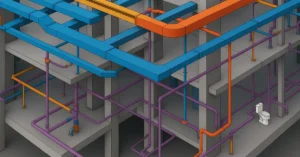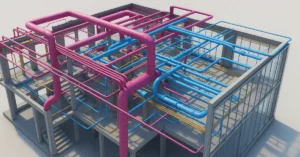Breakthroughs in Architectural Materials: What’s New in 2024?

In 2024, the architectural landscape is undergoing a remarkable transformation, driven by a fusion of sustainability, technological innovation, and pioneering design principles. As architects continue to push the boundaries of creativity and functionality, a host of breakthroughs in architectural materials are reshaping the way we conceive, construct, and inhabit built environments. From sustainable design to smart technologies, modular construction, and beyond, let’s explore the latest advancements that are revolutionizing the field of architecture.
Sustainable and Eco-Friendly Design
One of the most significant breakthroughs in architectural materials in 2024 is the increasing emphasis on sustainable and eco-friendly design practices. Architects are prioritizing the use of renewable materials, energy-efficient designs, and green spaces to minimize the environmental impact of buildings. By integrating sustainable features such as solar panels, rainwater harvesting systems, and natural ventilation, buildings can achieve a significant reduction in energy consumption, leading to a greener and more sustainable future.
Smart Homes and Buildings
The advent of smart homes and buildings is another notable breakthrough in architectural materials. With the integration of Internet of Things (IoT) technologies, buildings are becoming more intelligent, efficient, and responsive to the needs of their occupants. From automated lighting and climate control systems to advanced security and surveillance features, smart buildings offer enhanced comfort, convenience, and energy management capabilities, revolutionizing the way we live and work.
Modular and Prefabricated Construction
Modular and prefabricated construction methods have emerged as game-changers in the architectural industry, offering unparalleled efficiency, cost-effectiveness, and sustainability. By prefabricating building components off-site and assembling them on-site, construction projects can be completed in less time and with minimal disruption to the surrounding environment. Additionally, modular construction allows for greater flexibility and customization, enabling architects to create unique and innovative designs that meet the needs of diverse communities.
Biophilic Design
Biophilic design principles are gaining momentum in 2024, as architects recognize the importance of connecting human spaces with nature to improve wellbeing and productivity. By incorporating elements such as natural light, greenery, and water features into architectural designs, biophilic buildings create environments that promote health, happiness, and creativity. From living walls and rooftop gardens to indoor atriums and courtyards, biophilic design fosters a deeper connection to the natural world, enhancing the overall quality of life for building occupants.
Adaptive Reuse of Buildings
The adaptive reuse of buildings is a growing trend in architectural design, offering a sustainable solution for repurposing existing structures for new uses. Instead of demolishing old buildings, architects are finding creative ways to adapt and transform them into vibrant and functional spaces that serve the needs of modern society. Whether converting industrial warehouses into loft apartments, or repurposing historic landmarks into cultural centers, adaptive reuse preserves architectural heritage while reducing waste and minimizing environmental impact.
Minimalist and Functional Design
Minimalist and functional design principles are resonating with architects and designers in 2024, as they embrace the philosophy that less is more. By focusing on simplicity, clean lines, and efficient use of space, minimalist buildings achieve a timeless elegance and sophistication that transcends passing trends. With an emphasis on functionality and versatility, minimalist design fosters a sense of calm and clarity, creating spaces that are both aesthetically pleasing and highly practical.
3D Printing in Construction
The use of 3D printing technology in construction is revolutionizing the way buildings are designed and built in 2024. By layering materials such as concrete, plastic, or metal in precise patterns, 3D printers can create complex architectural forms with unparalleled speed and precision. From intricate facades and ornamental details to entire structural components, 3D printing offers architects unprecedented freedom and creativity in realizing their design visions. Additionally, 3D printing technology reduces material waste and construction time, making it a sustainable and cost-effective solution for building projects of all scales.
Emphasis on Community Spaces
In 2024, there is a renewed emphasis on community spaces in architectural design, as architects seek to create inclusive and vibrant environments that foster social interaction and connection. From public parks and plazas to communal gathering areas within residential developments, community spaces play a crucial role in promoting a sense of belonging and well-being among residents. By integrating features such as seating areas, playgrounds, and cultural amenities, architects are revitalizing urban landscapes and strengthening the social fabric of neighborhoods.
Resilient and Climate-Adaptive Architecture
Resilient and climate-adaptive architecture is a pressing need in the face of escalating climate change impacts. In 2024, architects are employing innovative design strategies and materials to create buildings that can withstand extreme weather events, rising sea levels, and other environmental challenges. From elevated structures and flood-resistant materials to passive heating and cooling systems, resilient buildings are designed to adapt and thrive in a changing climate, ensuring the safety and comfort of their occupants for generations to come.
Mixed-Use Developments
Mixed-use developments are gaining popularity in 2024 as architects embrace a more integrated approach to urban planning and design. By combining residential, commercial, and public uses within a single development, mixed-use projects create dynamic and diverse urban environments that promote walkability, sustainability, and livability. From mixed-use towers with retail and office space on lower floors to mixed-use neighborhoods with a mix of housing types and amenities, these developments foster a sense of community and provide residents with convenient access to essential services and recreational opportunities.
Conclusion
In conclusion, the breakthroughs in architectural materials in 2024 reflect a paradigm shift towards sustainability, innovation, and inclusivity in the field of architecture. From sustainable design practices and smart technologies to modular construction and biophilic principles, architects are embracing new approaches and materials to create buildings that are not only aesthetically pleasing but also environmentally responsible, resilient, and adaptable to the needs of future generations. As we continue to push the boundaries of architectural innovation, these breakthroughs promise to shape the built environment in profound and transformative ways, creating spaces that inspire, uplift, and endure for years to come.
If you’re interested in learning more about architecture firms in Europe, check out this comprehensive list of the top 50 firms compiled by Archgyan. From innovative startups to long-established industry leaders, this list has it all. Take a look and discover some of the most inspiring and influential architecture firms in Europe today.
If you’re interested in architecture and want to learn more about this amazing field, subscribe to our podcast on youtube
For more SketchUp tutorials, head to https://www.sketchupguru.com










